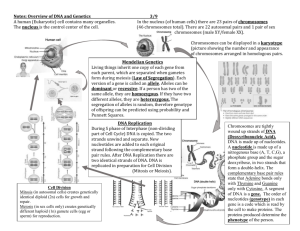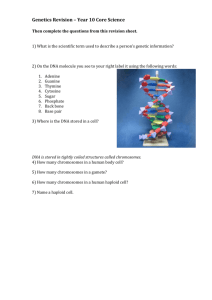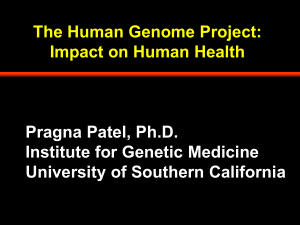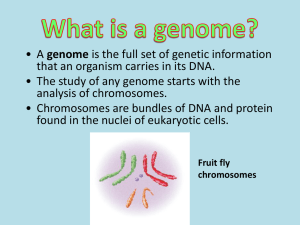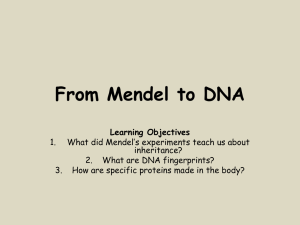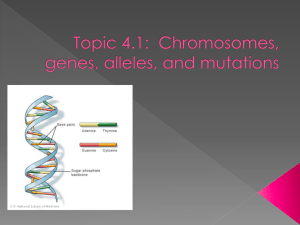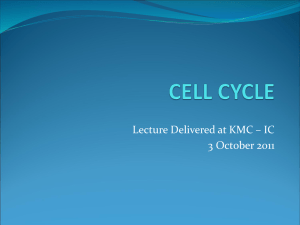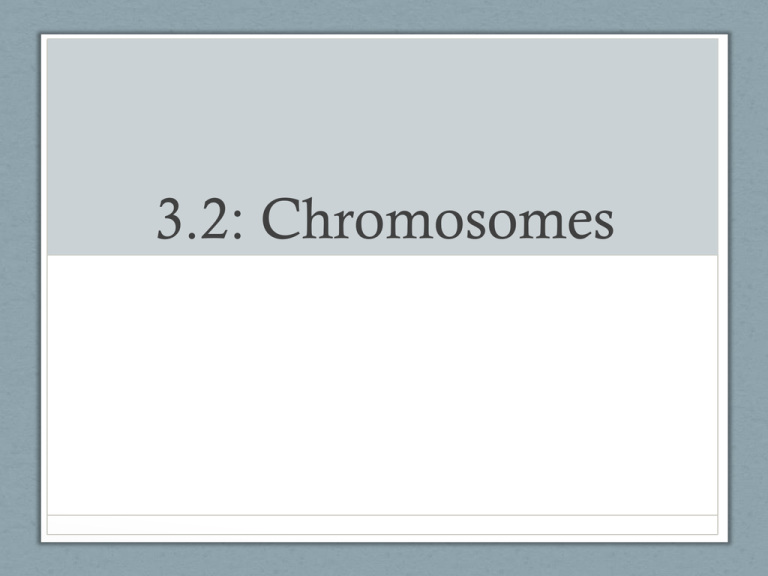
3.2: Chromosomes
Prokaryotes
One chromosome (single
copy of each gene).
DNA is not associated with
proteins (naked).
Plasmids are present in
prokaryotes in MOST cases.
Plasmids
Typically only found in prokaryotes
Contain some useful DNA e.g. genes for antibiotic
resistance
Can easily transferred between cells – even between
species.
Scientific research takes advantage of these traits.
Eukaryotes
DNA is linear
A long single
strand
Beads on a string
Each bead is a
nucleosome
A nucleosome is DNA
wrapped around 8
histones.
DNA has negative charge,
histone is positive.
DNA becomes
condensed/supercoiled.
Forming chromosomes.
Nucleosome
Nucleosome is a fairly
large complex of 8
proteins and 146
nucleotides-long DNA.
Chromosome terminology
1. Telomere
2. Centromere
3. Short chromatid
4. Long chromatid
Task
1. What is the Human genome project?
Dates? Aims? Findings?
2. What were the techniques used in the
project?
3. Where did the material come from?
Ethical considerations?
4. Who ‘controls’ this information? How
should/could it be used?
5. Junk/satellite DNA, what? Why?
6. Future applications of this research?
The Human Genome.
The complete sequence of Human DNA.
Genome of eukaryotes has lots of highly repetitive sequences. (545% of total genome). Between 5 – 300 base pairs per repetitive
sequence.
Satellite DNA – repetitive DNA clustered in discrete areas. Also
known as ‘junk DNA’
It is thought dispersed DNA has no specific coding function, but
can move from one location to another (transposable elements).
Importance not yet understood.
Who is Barbara McClintock?
Homologous chromosomes
Defined as: Two
chromosomes carrying
the same sequence of
genes.
Not identical because
although the genes are
the same, the alleles are
different.
Guess the genome…
E. Coli
5 million
base pairs
Paris Japonica
150,000
million
base pairs
T2 phage (virus)
0.18 million base pairs
Drosophila melangaster
140 million base
pairs
Homo sapiens
3000 million base
pairs
A - ancestral Eutherian
B - Chicken
C - Short-tailed opossum
D - Aardvark
E - Mink
F - Red fox
G - Ancestral Sciuridae
H - Mouse
I - Human
Locus of a gene
• The position of
a gene on a
chromosome
Haploid V’s Diploid
Haploid nuclei
• 23 chromosomes
(humans)
• Gametes (sex cells)
• Single copy of each
gene
Diploid nuclei
• 23 chromosome pairs
• Haploids fuse to form
zygote
• Two copies of each
gene
Reproduction by fusing haploid cells leads to much greater
variation, reduced chance of inheriting recessive mutations &
increased hybrid vigour (stronger offspring – sometimes!).
Who has the most
chromosomes?
78
24
Who has the most
chromosomes?
46
48
Sex chromosomes
X
X
X
XX
XX
Y
XY
XY
Female: XX
Male: XY
50% F
50% M
Every time!
Karyotyping & karyograms
Downs syndrome
1. Definition?
2. Causes?
3. Diagnosis?
4. Risk factors?
5. Prevalence?
6. Treatment?
Observing mitosis in garlic
root tip
• http://www.nuffieldfoundation.org/practicalbiology/investigating-mitosis-allium-root-tip-squash




